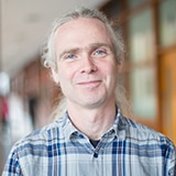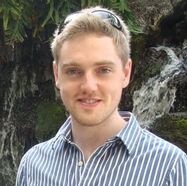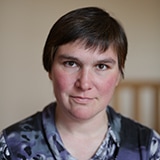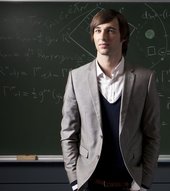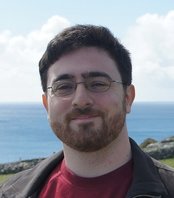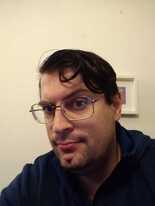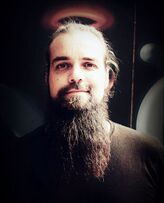Turlough Downes |
Prof Downes' research is focused primarily on the dynamics of flows in star forming regions. This includes addressing questions associated with (molecular cloud) structure formation and magnetic field behaviour in astrophysical turbulence, as well as the dynamics of proto-planetary disks. He is also involved in studying questions surrounding Fermi acceleration of relativistic particles at supernova shocks and gamma-ray bursts. The tool of choice for addressing these questions is numerical simulations and, where necessary, some of the world's largest supercomputers are used in the pursuit of a greater understanding of these systems.
|
I am an observational solar physicist interested in the initiation and early evolution of solar eruptive events. Solar eruptions are the largest and most energetic events occurring in our solar system, and they can have significant effects on the near-Earth environment. What initially causes the eruptions isn't very clear, and my research aims to investigate this. I'm interested in the very early stages of these eruptions, and how the different forces and features evolve and interact. I study these events mainly using observations in the extreme ultraviolet from space-based observatories such as the Solar Dynamics Observatory and Solar Orbiter, but I also use optical, X-ray, and radio wavelengths to gain a deeper insight into these eruptions. I'm also interested in the evolution of elemental abundance in the solar atmosphere. Elemental abundance of different solar features is fixed very low down in the solar atmosphere and provides a unique fingerprint of the magnetic structure and evolution of that structure. It is then possible to diagnose and probe these signatures using extreme ultraviolet spectra from spacecraft such as Hinode. In this case, the Sun acts as a local plasma laboratory, allowing us to study phenomena which can be used to probe and understand features elsewhere in the Universe.
Brien Nolan
|
My research focusses on different aspects of black holes and space-time singularities in the context of General Relativity (GR). This theory – Einstein’s geometric theory of the gravitational field – describes our universe as a 4-dimensional curved space-time. It provides the mathematical tools for the analysis of such phenomena as the gravitational collapse of stars to form black holes, the interaction and collision of black holes, the generation and propagation of gravitational waves (ripples in the curved space-time) and the evolution of the universe as a whole. In particular, I am interested in the Cosmic Censorship Hypothesis (CCH), the propagation of waves in curved space-times and the description of black holes (and other extended bodies) in isotropic universes. Studying the Cosmic Censorship Hypothesis involves trying to resolve the question of whether or not the singularity that inevitably forms as the end state of gravitational collapse is always hidden inside a black hole. The analysis of wave propagation in curved space-times is a non-trivial matter due to the fact that the waves don’t just spread out uniformly from their source (as on the surface of a pond): they can get trapped, distorted and pulled all the way around the black hole under the influence of its extreme gravitational field. Understanding the propagation of such waves is crucial for a full understanding of the generation and propagation of gravitational waves. In mathematical terms, both areas of research are linked by the study of wave equations in curved space-time, a topic that combines various different areas of mathematics (differential geometry, partial differential equations, Fourier analysis,…). In a different vein, I am also interested in using Einstein’s theory to find the appropriate mathematical description of black holes that exist not (essentially) in isolation, far from other material sources, but that are embedded in our expanding, galaxy-filled universe.
Masha Chernyakova |
My main scientific interests lie in the area of high energy astrophysics, which studies the most energetic events in the Universe. In my work I combine a theoretical approach of modelling of high energy sources with the analysis of multi wavelength experimental data. In particular I am interested in the mechanisms leading to particle acceleration and very high energy (VHE) emission in gamma-ray loud binaries and Galactic Centre (GC). While about half of the Galactic X-ray sources are binary systems, only few (less than 10) binary systems are able to produce TeV emission. The aim of my studies is to understand what makes these systems so special. Understanding of the origin of the high energy emission of the GC (e.g. hadronic or leptonic, diffusive or not) is important for understanding of the origin and properties of the cosmic rays in the central region. In addition to that I am also involved in the simulation of these VHE sources for Cherenkov Telescope Array (CTA).
Peter Taylor
|
My research is mainly concerned with classical and quantum aspects of black holes. From a quantum perspective, I am interested in quantum field theory in curved spacetimes and the associated theory of semi-classical gravity. The most famous prediction of this approximation--and one of the most surprising and far-reaching predictions of theoretical physics--is that black holes emit quantum thermal radiation, the so-called Hawking effect. On the classical front, I'm interested in the problem of motion in General Relativity including strong self-interaction effects. This is particularly important for modeling binary black hole systems where one black hole is much larger than the other, a key astrophysical source of gravitational waves being targeted by the European Space Agency's eLISA mission.
Abraham Harte |
My research focuses mainly on general relativity and other classical field theories. One major theme has been the theory of motion: How do the details of an object's internal structure affect its bulk movement or spin? How about a body's "own" electromagnetic, gravitational, or other fields? This is in essence the "self-force problem." There is no self-force at all in Newtonian gravity, although that changes in relativistic settings where Newton's third law fails and fields propagate at finite speeds. I have also been interested in the propagation of gravitational and electromagnetic waves in various contexts: gravitational lensing, wave optics in curved spacetimes, the consequences of caustic formation, and the buildup of nonlinear corrections over large distances. Most recently, I have been investigating the nonlinear structure of Einstein's equation in a broad sense, and finding that in various physically-relevant cases, the "intrinsic nonlinearity" is considerably less than might have been expected; traditional approaches employ variables which are poorly adapted to the equations at hand. I am working to generalize this and to better understand how it can be used to develop a more effective perturbation theory.
Oisin Creaner |
Dr. Creaner is an interdisciplinary scientist who focusses on the application of high-performance computing to astrophysical data analytics challenges. His research has focussed on observational astronomy across the spectrum from radio to visible to high-energy particle astronomy. At DCU, he has built an interdisciplinary team including a web developer, a PhD researcher in Machine Learning and several physics students. this team is working on several distinct but related projects. The first is Star Guide, funded under the National Open Research Forum, a project to support and enable citizen scientists to participate in cutting edge astronomical research, observing exoplanet transits to keep track of transit times. A second project applies Computer Vision techniques to the challenge of astronomical image processing, and has the potential to accelerate the interpretation of images taken from the sky. Other projects include the simulation of photometric and spectroscopic variability and the prediction of Jupiter transits from distant observers. He maintains close collaborations with a team in the Dublin Institute for Advanced Studies and Maynooth University, simulating and developing new astronomical detectors called MKIDs. He works closely with a team in Technological University Dublin to identify optimum fields for differential photometry. He has partnered with the ExoClock (associated with ESA) and Exoplanet Watch (associated with NASA) citizen science projects. Dr. Creaner is currently the secretary of the Astronomical Society of Ireland, treasurer of the Computational Physics Group at the Institute of Physics and a member of the Royal Irish Academy's Physical Chemical and Mathematical Sciences multidisciplinary committee.
Robert Brose |
My research focuses on high-energy astrophysics in the context of supernova remnants and gamma-ray astronomy. Massive stars tend to explode at the end of their lifetime, releasing about the same energy that our sun is emitting in its 10-billion-year long lifecycle within a few seconds, and as a result sending powerful blast waves out into our Galaxy. These blast waves are able to energize particles from the surrounding medium to energies well beyond anything we can do with all our technical possibilities.
Using the measurements of the particles that leave the remnants and make it to earth after a long journey - called cosmic rays or high-altitude radiation - and measurements of the gamma-ray emission that these particles cause while still being inside the remnants, I try to improve our theoretical understanding of the acceleration process that takes place inside the remnants. As a result, I helped to develop the numerical toolset RATPaC (Radiation Acceleration Transport PArallel Code) to study the acceleration of high-energetic non-thermal particles in the shock-waves succeeding supernova explosions and was/am involved in the very-high gamma-ray observatories VERITAS and H.E.S.S..
Using the measurements of the particles that leave the remnants and make it to earth after a long journey - called cosmic rays or high-altitude radiation - and measurements of the gamma-ray emission that these particles cause while still being inside the remnants, I try to improve our theoretical understanding of the acceleration process that takes place inside the remnants. As a result, I helped to develop the numerical toolset RATPaC (Radiation Acceleration Transport PArallel Code) to study the acceleration of high-energetic non-thermal particles in the shock-waves succeeding supernova explosions and was/am involved in the very-high gamma-ray observatories VERITAS and H.E.S.S..
